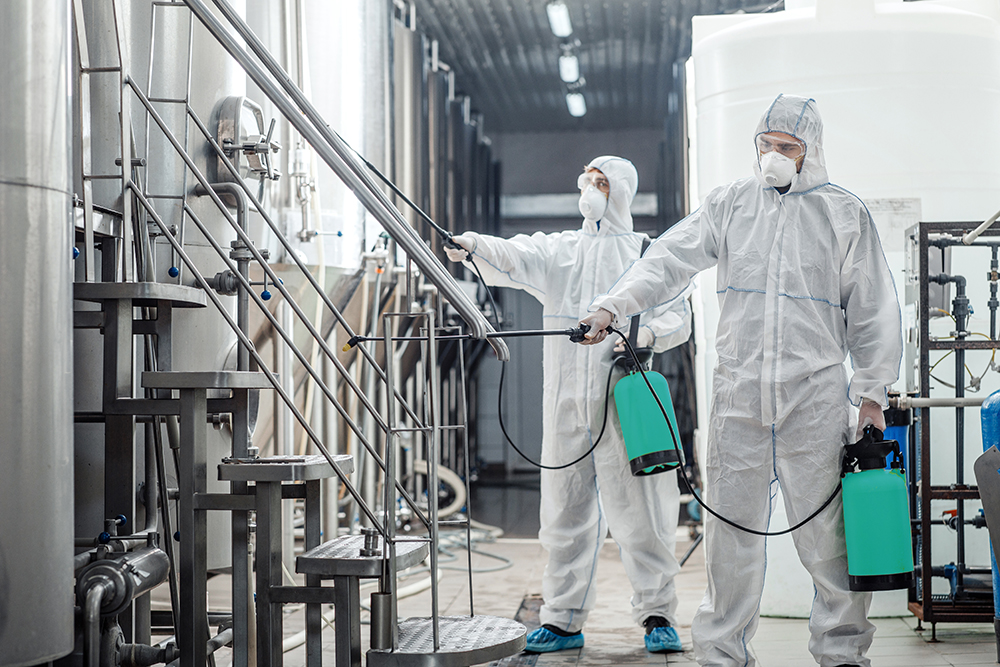Commercial cleaning for industrial spaces presents unique challenges for professional janitorial services and commercial cleaning companies, particularly as businesses implement new protocols to reduce the risk of pathogen transmission in the workplace.
Industrial facilities such as distribution centres, manufacturing sites, technical facilities and warehouses require specialized industrial cleaning and disinfection procedures. Experienced commercial cleaning technicians are essential, especially when it comes to cleaning machinery. Without the right products, equipment and expertise, machinery can potentially be damaged in the cleaning and disinfection process.
In order to produce the goods and services they do, industrial facilities adhere to specific schedules and routines. So it is crucial that your industrial cleaning company is able to provide a custom commercial cleaning plan to coordinate with your facility’s specific timelines and requirements, and to keep your premises clean, safe and healthy for all occupants at all times.
While some industrial facilities were able to remain open during the pandemic, many are just resuming operations now. As they reopen, many are working beyond capacity and implementing multiple shifts to fulfill delayed or postponed supply and service demands. Businesses are looking for solutions to help meet the heightened standards of cleaning and disinfection required to accommodate the increased frequency of operating schedules and shift rotations.
To respond to the demand for enhanced levels of cleaning and disinfection in the workplace, professional industrial cleaning services are employing foggers and electrostatic sprayers to apply disinfectant solutions, particularly in large facilities and those with difficult to reach areas.
Fogging and electrostatic technologies provide comprehensive and effective cleaning and disinfection in the industrial work environment, to help reduce the risk of disease transmission and offer peace of mind for managers and employees alike.
Facility managers want to educate themselves about these technologies, to make informed decisions about which are most suitable for their particular buildings and industry. The following is a summary of some key advantages and disadvantages of disinfecting fogging and electrostatic cleaning and disinfecting for industrial spaces.
Disinfecting fogging or misting
Disinfecting fogging or misting delivers a dry fog or wet mist of disinfectant solution that deposits on surfaces based on the direction of spray and the effect of gravity.
Advantages
- Foggers disinfect the air as well as the surfaces and objects in a room, so this method is often used in healthcare settings.
- Fogging offers a quick and easy way to disinfect large areas with minimal disruption.
Disadvantages
- Longer wait and work interruption times. Depending on the type of fogger used, it may take one to four hours to complete the job and allow for the safe re-entry of occupants into the space.
- Fogging and misting can result in uneven coverage and pooling of disinfectant and does not always reach all surfaces in a given area.
- Because it puts technicians at risk of inhaling disinfectant, the use of foggers requires substantial PPE during the application process.
Electrostatic disinfecting or electrostatic cleaning
Electrostatic disinfecting or electrostatic cleaning delivers charged droplets of disinfectant that are electrostatically attracted to most surfaces including undersides and crevices, regardless of the direction of spray, providing complete wrap-around disinfection coverage.
Advantages
- With electrostatic spraying, disinfectant can be applied to hard-to-reach surfaces, and all objects are covered evenly with a single spray without pooling. This makes it ideal for large areas with many nooks and crannies, lots of equipment or furniture, and objects that are difficult to lift or access underneath.
- Short waiting times. As soon as the surfaces and objects are dry, which is often only a few minutes, occupants may return to the area.
- Electrostatic spraying uses less product because it distributes the disinfectant evenly, in a fine mist, which improves efficiency while reducing waste and reduced costs of both product and labour.
Disadvantages
- Depending on the size of the area to be treated, the electrostatic application process can take longer than misters or foggers.
- Not all surfaces have a negative charge, or they may be made of “insulator” materials. In these rare circumstances, the positively charged disinfecting solution from the electrostatic sprayer will not bond as it does to most other materials.
ServiceMaster Clean is aligned with Health Canada recommendations and has the experience and resources to implement effective preventive cleaning and disinfecting protocols to help prevent outbreak and spread of infectious disease within industrial facilities of all types and scale.
